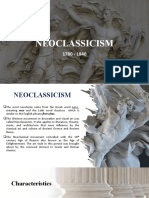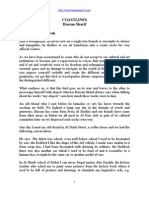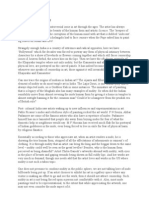What Is Pakistani Art
What Is Pakistani Art
Uploaded by
Hassan Imran AliCopyright:
Available Formats
What Is Pakistani Art
What Is Pakistani Art
Uploaded by
Hassan Imran AliOriginal Title
Copyright
Available Formats
Share this document
Did you find this document useful?
Is this content inappropriate?
Copyright:
Available Formats
What Is Pakistani Art
What Is Pakistani Art
Uploaded by
Hassan Imran AliCopyright:
Available Formats
Sarah Imran Ali Roll Number: 164 4th Year-Painting Major
WHAT IS PAKISTANI ART? Being a student of fine art, Ive heard the term Pakistani art one too many times, never really thinking about what it means. It instantly makes one wonder whether its art from Pakistan or art created by a Pakistani artist. The answer I believe is still ambiguous regardless of the option you pick. Having grown up in a city rich in Mughal culture, Lahore, I have always been surrounded by art. Whether it was the play based on the life story of Anarkali, a field trip to Jehangirs tomb, watching Naheed Siddiques feet move to the beat of tablas or just looking at the miniature paintings hanging in my grandparents lounge, Ive always been influenced by the art around me, the art I always referred to as Pakistani. Today, I sit here wondering whether I have the right to call any of it my very own, for there is no specific criteria the contemporary world provides us with to classify our work as Pakistani. Do we still claim the miniature paintings the Mughals left us with as Pakistani, whereas the Indians can rightly call it theirs too? Is it then the technique that we proudly show off as our own although contemporary miniature artists have changed its original meaning almost completely for instance local artist such as Aakif Suri and Sajid Khan,use the traditional miniature painting technique but makes massive paintings somewhat eliminating the original barriers of miniature art. Could we be referring to the traditional subject matter used by these artists? Or are we blinding ourselves by ignoring all the miniature work that is being produced around us in the 21st century, a time period with colleges like my own, the National College of Arts that are dedicated to helping students understand the essence of the past, but produce work that on many levels cannot be related to classical miniature. Artists like Mudassar Manzoor, Shazia Sikander, Ayesha Durrani, and Huma Mulji all produce pieces that revive the art of miniature paintings, deal with the question of identity in reference to politics and culture and address the issue of gender, age and personal issues through their work. I am in no way claiming miniature painting as the only kind of art produced in Pakistan, today the Pakistani art scene is very similar to the work produced worldwide and include many other forms such as calligraphy, painting, sculpture, printmaking, installation art, video and media art etc. All these art forms draw their inspirations from history and from the modernity of expression. The Pakistani artist, like those found anywhere else in the world seeks to recreate text in a modern context. Why then does it leave us with no room to call any of it our own? Another question arises when one thinks of Pakistani art, are we as Pakistanis referring to anyone who belongs to the country, even if he/she lives elsewhere as a Pakistani artist? Will we then also refer to their work as Pakistani art? In my opinion this is our mandate for judging an art piece and calling it Pakistani not realizing that these artists no longer live in this country and are no longer subjected to, the bad or the good on goings that they so confidently speak off. It also however varies from artist to artist, some of whom choose to use the title of a Pakistani artist, not only because of their affiliation with or love for the country but also for promotional and popularity basis. Whereas others, slowly move as far away from the Pakistani art scene and the title of being a Pakistani artist because of the fear of being crushed and looked down upon in a contemporary world. Lets take the example of two renowned Pakistani artists who purely based on my opinion fit perfectly in both these categories. Shazia Siqander currently living in New York was educated and brought up in Pakistan, she received a high level of international recognition and her subject matter slowly changed from what could be called purely cultural to something totally relatable to the Western World alone. She slowly moved away from what was her own, and although still carries the label of a Pakistani artist, cannot really be judged as exactly that on the basis of her work. Another such example could be the work of Saira Wasim another artist from Lahore, Pakistan currently living in the United States, commenting on devastating politics. Saira's pet political topics are commenting on the vast chasm that exists between the West and the Islamic world, repression within Islamic world, and the new Western cultural imperialism. It is when one looks at leading artists like these that one realizes they really cant be called Pakistani artists at all. In conclusion, there is no correct answer or fair criteria by which one can judge what Pakistani art really is. The subject remains open to individual analysis and interpretation. In my opinion, the closest we can possibly get to calling a piece of art Pakistani is by assessing where the art originates from and what the artist himself wants to refer to his work as, i.e. take up the title of being known as a Pakistani artist or not. I say this because the contemporary art world is fast paced and although the past is always a great subject to reference or study, replicas are not really appreciated. The best criteria, although
Sarah Imran Ali Roll Number: 164 4th Year-Painting Major
conflicted in its nature would be calling an artist who chooses to be called Pakistani, regardless of how long he may have resided in the country itself, furthermore referring to his work as Pakistani art, although there is no definite way to establish or call any form of art truly Pakistani.
You might also like
- Shakir Ali: "Art in Pakistan" BFA-IV (Visual Arts) Class Incharge: Ms. Farah Khan Institute of Design & Visual Arts, LCWUDocument25 pagesShakir Ali: "Art in Pakistan" BFA-IV (Visual Arts) Class Incharge: Ms. Farah Khan Institute of Design & Visual Arts, LCWUGane Sindhu100% (1)
- Apartment C.08.1 Candy & CandyDocument45 pagesApartment C.08.1 Candy & CandyShane CroucherNo ratings yet
- IKEA 2009CatalogPreviewDocument46 pagesIKEA 2009CatalogPreviewmarius5600No ratings yet
- Art AppreciationDocument6 pagesArt AppreciationClariss RamosNo ratings yet
- What Is Art Philippine ArtDocument53 pagesWhat Is Art Philippine ArtBea Dacillo BautistaNo ratings yet
- ReportDocument14 pagesReportGrid CortezNo ratings yet
- The Historical Development of ArtDocument34 pagesThe Historical Development of ArtPristine SunNo ratings yet
- Cubism To Installation Art Comprehensive NotesDocument13 pagesCubism To Installation Art Comprehensive Notesramos.norvicNo ratings yet
- HMN101 Week 4Document28 pagesHMN101 Week 4Anthony BareraNo ratings yet
- Historical Development of Art p.1Document13 pagesHistorical Development of Art p.1Baniel, Khadijah L.100% (1)
- LESSON 11appropriation in Art ReportDocument20 pagesLESSON 11appropriation in Art ReportJv JapusNo ratings yet
- Notes On PhenomenologyDocument5 pagesNotes On PhenomenologyDon Chiaw ManongdoNo ratings yet
- History of PaintingDocument49 pagesHistory of PaintingDominic LimNo ratings yet
- Leandro V. LocsinDocument3 pagesLeandro V. LocsinMeann جرابيللوNo ratings yet
- Psy 1205 Lesson 1 - IntroductionDocument7 pagesPsy 1205 Lesson 1 - IntroductionJoseph KhaembaNo ratings yet
- NEOCLASSICISMDocument32 pagesNEOCLASSICISMthalassaNo ratings yet
- L5 Characteristics of Contemporary ArtsDocument30 pagesL5 Characteristics of Contemporary ArtsSepida MolzNo ratings yet
- Sts - Chapter - 1 Lesson 1Document34 pagesSts - Chapter - 1 Lesson 1Rhandel John ResiduoNo ratings yet
- Answer Key PE Reviewer Sept 2022 Set B.pdfsDocument13 pagesAnswer Key PE Reviewer Sept 2022 Set B.pdfsAlyssaMaeM CruzNo ratings yet
- Romantic ArtDocument16 pagesRomantic ArtJefray Omongos100% (1)
- Expressionism Art: Paras, Abegail ADocument10 pagesExpressionism Art: Paras, Abegail ARaffy AbrantesNo ratings yet
- Human Act and Act of ManDocument25 pagesHuman Act and Act of ManLowella May Tan ChengNo ratings yet
- What Is Popular CultureDocument21 pagesWhat Is Popular CultureKryztle BillenaNo ratings yet
- Southeast Asian Fabrics and AttireDocument5 pagesSoutheast Asian Fabrics and AttireShmaira Ghulam RejanoNo ratings yet
- 6th +Art+in+Early+CivilazationDocument30 pages6th +Art+in+Early+CivilazationChloe CatalunaNo ratings yet
- Asian ArtDocument46 pagesAsian ArtMaria Alyssa NaranjoNo ratings yet
- Zines in Philippine Punk Culture (Intro) by Dianne SiribanDocument26 pagesZines in Philippine Punk Culture (Intro) by Dianne Siribanruby soho100% (3)
- Visited Places by RizalDocument96 pagesVisited Places by RizallacbanesdianeNo ratings yet
- The Versatile Virtuoso - Srimati Lal, A Painter, An Artist, A Critic, A Curator, A Poet and A WriterDocument3 pagesThe Versatile Virtuoso - Srimati Lal, A Painter, An Artist, A Critic, A Curator, A Poet and A WriterDipti MudaliarNo ratings yet
- Female Artists of Pakistan, and Impact of Their Work On Global Art SceneDocument13 pagesFemale Artists of Pakistan, and Impact of Their Work On Global Art SceneAJHSSR JournalNo ratings yet
- Jagadish Chintala SculpturesDocument2 pagesJagadish Chintala SculpturessivaNo ratings yet
- SushmaJoshi2008 ArtMattersDocument122 pagesSushmaJoshi2008 ArtMatterssatyaNo ratings yet
- Shahzia Sikander - An EssayDocument9 pagesShahzia Sikander - An EssayTanmeet_GujralNo ratings yet
- Planet China Vol 02Document78 pagesPlanet China Vol 02Matteo DamianiNo ratings yet
- আর্ট-ইকো: ৯ম-১০ম বিশেষ সংখ্যা---একটি দৃশ্য শিল্পের কাগজDocument60 pagesআর্ট-ইকো: ৯ম-১০ম বিশেষ সংখ্যা---একটি দৃশ্য শিল্পের কাগজSushanta KarNo ratings yet
- Contemporary Visual Art - CoastlinesDocument3 pagesContemporary Visual Art - CoastlinesAbdulraheemNo ratings yet
- EssaysDocument31 pagesEssaysPraveenNo ratings yet
- Ws-Art 2Document28 pagesWs-Art 2Muhammad idreesNo ratings yet
- Indian Nudes and PrudesDocument2 pagesIndian Nudes and PrudesbCA GalleriesNo ratings yet
- EDU403 Assignment 1Document6 pagesEDU403 Assignment 1NadiaJawadHussain100% (1)
- An Intellegent Rebellion - Women Artists of PakistanDocument12 pagesAn Intellegent Rebellion - Women Artists of PakistanSaba AfzalNo ratings yet
- Manifestations of Social Realism Across Diverse Forms of Pakistani ArtDocument13 pagesManifestations of Social Realism Across Diverse Forms of Pakistani ArtsuperwomanxingNo ratings yet
- India Today, Feb 13, 2012Document2 pagesIndia Today, Feb 13, 2012ray_sharmisthaNo ratings yet
- Master Minds:Creativity in Picasso's & Husain's Paintings. Part 3: 1, 2, 3, 4, 5, #3From EverandMaster Minds:Creativity in Picasso's & Husain's Paintings. Part 3: 1, 2, 3, 4, 5, #3No ratings yet
- The Development of An Art History in the UAE: An Art Not Made To Be UnderstoodFrom EverandThe Development of An Art History in the UAE: An Art Not Made To Be UnderstoodNo ratings yet
- Art History Assignment 1Document3 pagesArt History Assignment 1api-742152746No ratings yet
- KAVITA NAYARDocument4 pagesKAVITA NAYARHarshpreet KaurNo ratings yet
- Master Minds: Creativity in Picasso's & Husain's Paintings (Part - 2): 1, 2, 3, 4, 5, #2From EverandMaster Minds: Creativity in Picasso's & Husain's Paintings (Part - 2): 1, 2, 3, 4, 5, #2No ratings yet
- Punk BookDocument36 pagesPunk BookSara ChaudhuriNo ratings yet
- Le CorbusierDocument6 pagesLe CorbusierBASMA FAHIM SIDDIQUINo ratings yet
- Essay - Is The Postmodernism Art A Lie For The New GenerationDocument2 pagesEssay - Is The Postmodernism Art A Lie For The New GenerationValeria SanchezNo ratings yet
- Desiderium For Art: A Reflection of Beauty in FacadeDocument1 pageDesiderium For Art: A Reflection of Beauty in FacadeFrances Mikayla EnriquezNo ratings yet
- Indian Painting ArtDocument9 pagesIndian Painting ArtvovznpcwjvarnsgdxzNo ratings yet
- Contemporary Miniature Painting in LahorDocument241 pagesContemporary Miniature Painting in LahorMohamed Abou El hassanNo ratings yet
- Ancient Chinese Painting On Contemporary ArtDocument73 pagesAncient Chinese Painting On Contemporary ArtChandan KumarNo ratings yet
- Art and PoliticsDocument15 pagesArt and Politicsis taken readyNo ratings yet
- Presentation RMDocument7 pagesPresentation RMMuhammad Mushtaq AliNo ratings yet
- Queer ArtDocument68 pagesQueer ArtCollect Art100% (2)
- Interview Omar GDocument4 pagesInterview Omar GOmar GilaniNo ratings yet
- Art Without Borders: Seven Inspiring Art Stories of Female ArtistsFrom EverandArt Without Borders: Seven Inspiring Art Stories of Female ArtistsNo ratings yet
- Zahoor Ul AkhlaqDocument2 pagesZahoor Ul AkhlaqHasan JamalNo ratings yet
- Acropolis of AthensDocument10 pagesAcropolis of AthensShyamol BoseNo ratings yet
- 6th Grade Sketchbook AssignmentsDocument4 pages6th Grade Sketchbook AssignmentsShruti BajajNo ratings yet
- Not A Demon - LocationsDocument9 pagesNot A Demon - Locationskenneth soendjojoNo ratings yet
- Tattoos: History, Meaning and Tattooing in El SalvadorDocument13 pagesTattoos: History, Meaning and Tattooing in El SalvadorMario López LeivaNo ratings yet
- Catalog Katalog Mulia Tile-Low-WebDocument53 pagesCatalog Katalog Mulia Tile-Low-WebDika DikaNo ratings yet
- Circuit 1: The Discovery of Lady Cao - Trujillo and El BrujoDocument9 pagesCircuit 1: The Discovery of Lady Cao - Trujillo and El BrujoyolymonjalopezNo ratings yet
- Elements and Principles of Contemporary Art FormsDocument25 pagesElements and Principles of Contemporary Art FormsDaphne ComendadorNo ratings yet
- Art AnalysisDocument10 pagesArt Analysisaibajo2004No ratings yet
- Alice Boner and GeometryDocument8 pagesAlice Boner and Geometrynandana11No ratings yet
- Thailand Itinerary 2023Document2 pagesThailand Itinerary 2023Mylene LacsonNo ratings yet
- 1625560219Document44 pages1625560219Gaurav AggarwalNo ratings yet
- Art As Viewed by PhilosophySubject and Content-6-Files-MergedDocument195 pagesArt As Viewed by PhilosophySubject and Content-6-Files-MergedJohn Joshua MiclatNo ratings yet
- Christopher MarleyDocument2 pagesChristopher MarleyrobinbabuscribdNo ratings yet
- Clarence HolbertDocument10 pagesClarence Holbertbalachandhar.s9301No ratings yet
- ACI 363R-92 Report On High Strength Concrete (55 P)Document55 pagesACI 363R-92 Report On High Strength Concrete (55 P)Jorge Gutierrez100% (4)
- Baltazar and The Flying PiratesDocument13 pagesBaltazar and The Flying PiratesImmedium100% (1)
- Moor Wearing Turbans On SC PlantationDocument10 pagesMoor Wearing Turbans On SC PlantationUnited Noble Moors100% (1)
- Giornale 140 Biennale-Session BassoDocument16 pagesGiornale 140 Biennale-Session BassojoeykeysNo ratings yet
- Arts and CraftsDocument4 pagesArts and CraftsBob FloresNo ratings yet
- The Colossal Statue of MenkauraDocument7 pagesThe Colossal Statue of MenkauradanielblambertNo ratings yet
- Diversity Through Visual Art 27279 20230915150613Document244 pagesDiversity Through Visual Art 27279 20230915150613trannguyenanhuy2002No ratings yet
- CPAR summative testDocument2 pagesCPAR summative testApril CatapangNo ratings yet
- Caspar David FriedrichDocument2 pagesCaspar David Friedrichapi-278696718No ratings yet
- Should Graffiti Be Considered ArtDocument2 pagesShould Graffiti Be Considered ArtAnescu MihaiNo ratings yet
- Curriculum Map: Subject: Arts Grade Level: 7 Quarter: First QuarterDocument4 pagesCurriculum Map: Subject: Arts Grade Level: 7 Quarter: First QuarterKristela Mae ColomaNo ratings yet
- Lesson-4 Function of ArtsDocument23 pagesLesson-4 Function of ArtsChat GazaNo ratings yet
- "I Can Do All Things Through Christ Who Strengthens Me." Phil.4:13Document5 pages"I Can Do All Things Through Christ Who Strengthens Me." Phil.4:13Sharmaine AyanoNo ratings yet
- Kenoyer1992 - Ornament Styles of The Indus Valley Tradition EvDocument20 pagesKenoyer1992 - Ornament Styles of The Indus Valley Tradition EvRitwik KesarwaniNo ratings yet

























































































